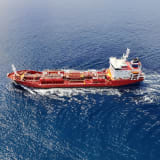
A popular pastime among shipping analysts recently has been to pass around slides with the age profile of the bulker fleet, and noting how an increasing percentage of the fleet will supposedly be in the “overage bracket” as the first vessels from the massive delivery wave from 2009 onwards celebrate their 15th anniversary in 2024.
Undoubtedly, the Capesize fleet age profile depicted below is lopsided, with nearly a third (32%) of the fleet delivered during three manic years (2010 through 2012). However, statistics for the average scrapping age suggest that the “15 years is overage” argument is optimistic at best. Since 2018, the average age of beaching a Capesize has been remarkably steady at 23—25 years, dropping to 20 years only in the freight market depression of 2016.
Yes, many large charterers have a policy of not chartering “overage” tonnage, typically with a limit of 15 years. Yet, older vessels still find opportunities in niche trades with less strict charterers, and with increasing freight market volatility and occasional bouts of market tightness expected, the goal post for what is acceptable tonnage will almost certainly be moved.
There is another mechanism through which the age profile can start to bite, though, and that is the share of the fleet in drydock for special survey, roughly at the age of 10 and 15 years old. It’s worth keeping in mind that these ships were extremely expensive and built during a time when speedy delivery mattered more than top specifications, often at new and untested yards. They were also delivered into a depressed freight market, which might have led to the occasional corner cutting on maintenance standards.
Combine this with a challenging picture for yard capacity, and we are now starting to see some lengthy repair stays, even for relatively young (2014-built) tonnage. A quick check of the 12 Capesize vessels currently listed as in a repair yard on Signal Ocean reveals an expected average duration of as much as 44 days (incl. waiting at anchorage), ranging from a low of 23 days to a high of 59 days. A back-of-the-envelope calculation on the basis of a 44-days special survey drydock duration and the current age profile suggests that around 1.7% of Capesize fleet capacity was lost due to off hire in 2023 and that this will increase to an estimated 2.0% in 2024 and an estimated 2.7% in 2025—reducing the effective fleet growth by 0.3% and 0.7%, respectively. That might just matter in a tightening freight market where projected Capesize fleet growth and deliveries are already low.
By Dr Roar Adland, Global Head of Research, SSY

Articles
You may also be
interested in
View allGet in touch
Contact us today to find out how our expert team can support your business














